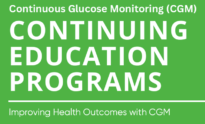CGM Technology and Digital Health

Download a comprehensive listing of continuing education (CE) programs for pharmacists, physicians and nurses on the topic of CGM.
Learn MoreProgram Description
Patients with diabetes who are hospitalized and have uncontrolled blood glucose levels are at a higher risk for morbidity, mortality, and health care costs. Pharmacists practicing within hospital and health-system settings can identify patients who might benefit from continuous glucose monitoring (CGM) devices. This program will outline responsibilities for health-system pharmacists to improve the integration of CGM into practice for appropriate patients. The panelists will discuss insurance coverage options, potential cost considerations, and the importance of follow-up communication with patients to address initial challenges. Panelists will share their collective experience and discuss opportunities for collaboration to ensure a smooth transition to CGM use after discharge.
Target audience: Health-system and community pharmacists
Type of activity: Application
This Payer IMPACT Brief summarizes the key points of a Satellite Symposium held at the Academy of Managed Care Pharmacy 2024 Annual Meeting.
Learn MoreThis article provides a comprehensive summary of the latest discoveries in the category of continuous glucose monitoring (CGM). It compiles the most recent scientific findings in an easy-to-read format, complete with hyperlinks and QR codes to full-text articles and abstracts. Read here to learn how increased implementation and expanded access to CGM may improve clinical and economic outcomes and reduce diabetes-related healthcare utilization and costs.
Key Topics:
- 2024 Clinical Practice Updates and Quality Measure Changes
- Emerging Evidence for CGM Use in Non-Intensively Treated Type 2 Diabetes
- Reduction in Healthcare Resource Utilization and Mortality
- Real-World Data Showing CGM Reduces Costs
- Utilization of GLP-1 Agonists in Conjunction with CGM
The poster outlines best practices for health plan coverage and access to Continuous Glucose Monitoring (CGM) for diabetes management, emphasizing the technology’s transformative impact on care. It recommends aligning coverage criteria with current medical evidence, enhancing utilization oversight, and improving access for underserved populations. Strategies include offering CGM under pharmacy benefits, educating healthcare providers and patients, and developing support systems for at-risk groups. The best practices, derived from expert interviews, a national survey, and a workshop, aim to assist health plan decision makers in optimizing diabetes outcomes and managing healthcare costs efficiently.
Learn MoreThe ADA Standards of Care include all of of the organization’s current clinical practice recommendations and are intended to provide clinicians, patients, researchers, payers, and others stakeholders with best practices in diabetes management, general treatment goals, and tools to evaluate the quality of care. The recommendations are based on an extensive review of the clinical diabetes literature, supplemented with input from ADA staff and the medical community at large. These comprehensive guidelines are updated annually, or more frequently online if new evidence or regulatory changes merit immediate incorporation In alignment with previous versions of the ADA Standards of Care, the 2024 update highlights the clinical benefit of CGM across a wide range of patient types based on a growing body of evidence.
Learn MoreWhile CGM systems were initially prescribed predominantly for patients with T1D, the mounting body of literature and expert recommendations have led to more widespread use in insulin-treated T2D and beyond. Based on RCT and real world evidence supporting CGM use in T2D and published literature demonstrating the utility of CGM in population health, 4 payer and 5 health system experts convened virtually to share their insights on the integration of this technology in current programs. This article provides a review of key evidence discussed by these stakeholders and findings from the meeting, with recommendations for the implementation of T2D population health programs integrating CGM with other interventions.
Learn More